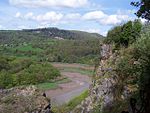Lancaut
Church ruins in EnglandDeserted medieval villages in GloucestershireFormer civil parishes in GloucestershireRiver WyeTidenham ... and 1 more
Use British English from July 2015

Lancaut (Welsh: Llan Cewydd) is a deserted village and former civil parish, now in the parish of Tidenham, in the Forest of Dean district, in Gloucestershire, England, located alongside the River Wye, around two miles north of Chepstow. It occupies a narrow-necked promontory formed by a curve of the river, which acts as the border between England and Wales. Little remains of the village today, except for the roofless church of St. James.
Excerpt from the Wikipedia article Lancaut (License: CC BY-SA 3.0, Authors, Images).Lancaut
Lancaut Walk, Forest of Dean Tidenham
Geographical coordinates (GPS) Address Nearby Places Show on map
Geographical coordinates (GPS)
| Latitude | Longitude |
|---|---|
| N 51.666335 ° | E -2.672217 ° |
Address
Lancaut Walk
NP16 7JB Forest of Dean, Tidenham
England, United Kingdom
Open on Google Maps









